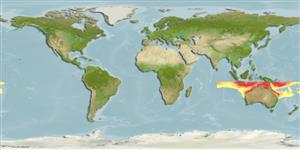Elasmobranquios (tiburones y rayas) (sharks and rays) >
Carcharhiniformes (Ground sharks) >
Carcharhinidae (Requiem sharks)
Etymology: Rhizoprionodon: rhiza (Gr.), root; prion (Gr.) saw; odon (Gr.), tooth, referring to teeth with serrated (saw-like) bases, or roots [replacement name for Rhizoprion Ogilby 1915, preoccupied by Rhizoprion Jourdan 1861 in mammals] (See ETYFish); taylori: In honor of entomologist Frank Henry Taylor (1886-1945), Institute of Tropical Medicine, Townsville, North Queensland, Australia, who collected holotype (See ETYFish).
Eponymy: Frank Henry Taylor (1886–1945) was an entomologist at the Institute of Tropical Medicine, Townsville, Queensland, Australia. [...] (Ref. 128868), visit book page.
More on author: Ogilby.
Environment: milieu / climate zone / depth range / distribution range
Ecología
marino; rango de profundidad ? - 300 m (Ref. 75154). Tropical; 8°S - 28°S
Distribución
Países | Áreas FAO | Ecosistemas | Ocurrencias, apariciones | Point map | Introducciones | Faunafri
Western Pacific: off Papua New Guinea and northern Australia.
Length at first maturity / Tamaño / Peso / Age
Maturity: Lm 47.0, range 42 - ? cm
Max length : 69.1 cm TL macho / no sexado; (Ref. 9161); edad máxima reportada: 7 años (Ref. 9161)
Espinas dorsales (total) : 0; Espinas anales: 0. Brownish grey above, white below, fins light-edged but not conspicuously marked (Ref. 9997).
A little-known shark (Ref. 9997) found on the continental shelf from close inshore to a depth of at least 110 m (Ref. 6871). Feeds mainly on fishes, but also takes cephalopods and crustaceans (Ref. 6871). Viviparous (Ref. 50449). Caught frequently by inshore demersal gillnet fisheries off Papua, but rarely elsewhere. Utilized for its fins and meat (Ref.58048). Too small to be of any commercial importance (Ref. 6871).
Life cycle and mating behavior
Madurez | Reproducción | Puesta | Huevos | Fecundidad | Larva
Viviparous, with a yolk-sac placenta (Ref. 9997) and 1-10 pups after a gestation period of 11-12 months; born at ~ 25 cm TL; very rapid growth (Ref.58048). Distinct pairing with embrace (Ref. 205).
Compagno, L.J.V., 1984. FAO Species Catalogue. Vol. 4. Sharks of the world. An annotated and illustrated catalogue of shark species known to date. Part 2 - Carcharhiniformes. FAO Fish. Synop. 125(4/2):251-655. Rome: FAO. (Ref. 244)
IUCN Red List Status (Ref. 130435: Version 2024-1)
Threat to humans
Harmless
Human uses
Pesquerías:
Herramientas
Special reports
Download XML
Fuentes de Internet
Estimates based on models
Preferred temperature (Ref.
123201): 22.5 - 28, mean 26.6 °C (based on 321 cells).
Phylogenetic diversity index (Ref.
82804): PD
50 = 0.5078 [Uniqueness, from 0.5 = low to 2.0 = high].
Bayesian length-weight: a=0.00427 (0.00202 - 0.00902), b=3.10 (2.93 - 3.27), in cm total length, based on LWR estimates for this Genus-body shape (Ref.
93245).
Nivel trófico (Ref.
69278): 4.5 ±0.0 se; based on diet studies.
Generation time: 2.6 ( na - na) years. Estimated as median ln(3)/K based on 2
growth studies.
Resiliencia (Ref.
120179): Muy bajo, población duplicada en un tiempo mínimo superior a 14 años (K=1.01-1.34; tm=1; tmax=7; Fec=1-8).
Fishing Vulnerability (Ref.
59153): Low to moderate vulnerability (33 of 100).
